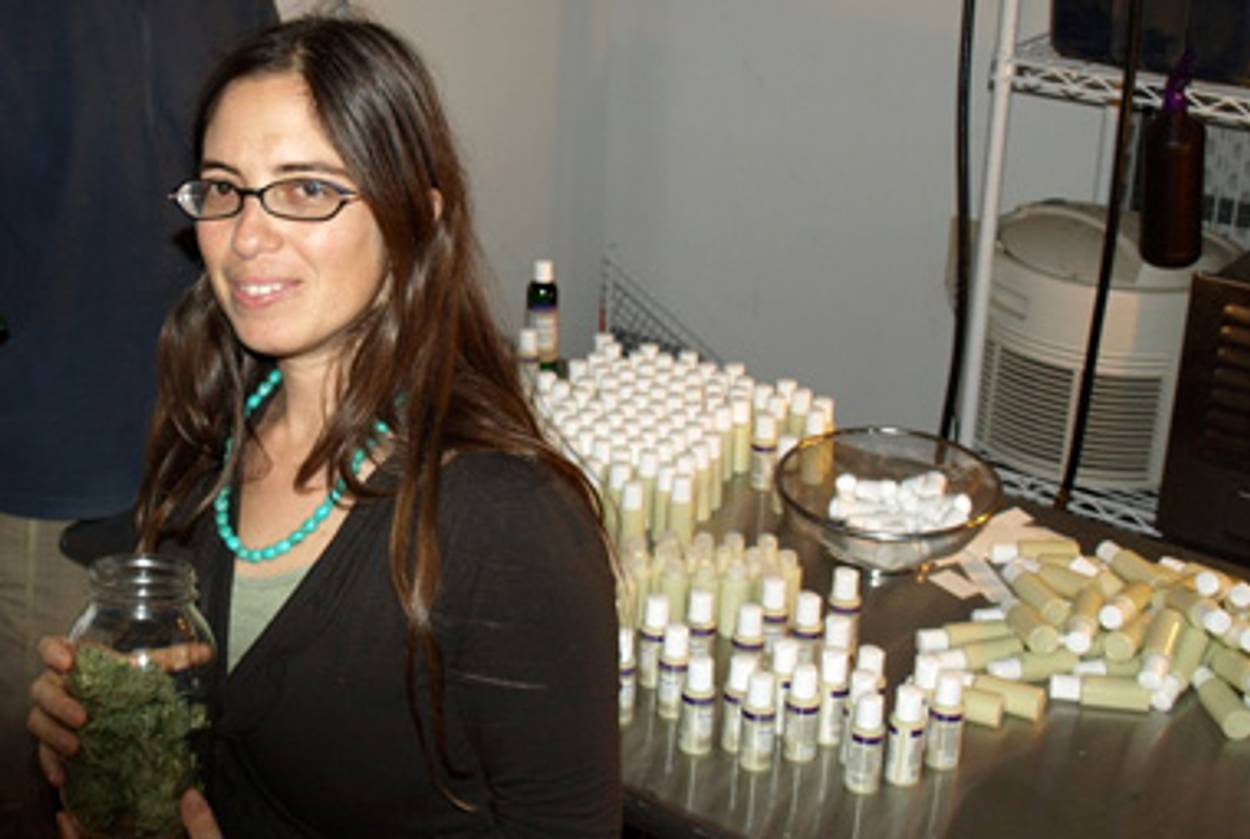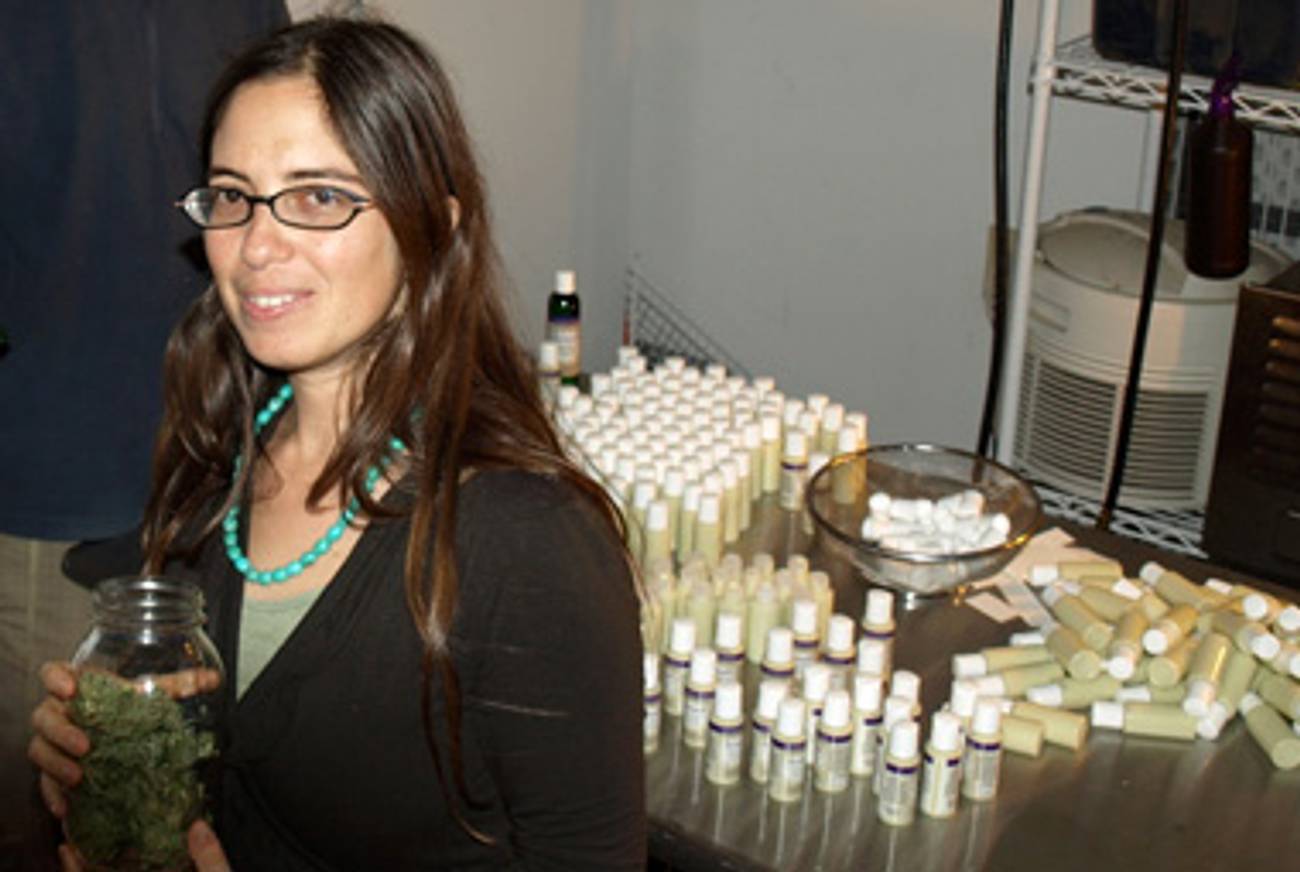Contact High
In Berkeley, three Orthodox Jews run a medical-marijuana collective selling a religiously inspired cannabis cream




On a late summer afternoon in Berkeley, California, Eliezer “Sticky” Green, a bearded hipster in hemp shorts and a Green Festival T-shirt, is sitting across the street from his medical-marijuana collective, smoking a joint. It’s not an uncommon sight in the East Bay—home of the country’s first cannabis trade school, Oaksterdam University—but an hour later Green is doing something a bit more out of character for the Bay Area: He’s wrapping tefillin and davening mincha, the afternoon prayers.
In Northern California, even the religious Jews light up.
Green, 32, is a founding member of Doc Green’s, a medical-marijuana collective established by Orthodox Jews, who, like the late kabbalistic rabbi Aryeh Kaplan, believe that cannabis was one of the ingredients in the holy anointing oil described in the Torah. Working in a commercial loft space where sets of the Zohar and Midrash line the bookshelves and the Grateful Dead is heard as often as Hasidic melodies, the collective’s founders combine cannabis extract with fair-trade shea butter to produce Doc Green’s therapeutic healing cream, a medicinal lotion used to treat ailments from sore muscles to eczema.
“As a Jew, it’s about the power to be able to heal people,” says Green, whose father is a retired Orthodox rabbi. “I want to go to nursing homes and rub down 85-year-olds who voted for Republicans and hated pot.”
California was the first state to legalize medical marijuana in 1996, leading to the creation of patient collectives like Doc Green’s, which sells lotion to its roughly 300 members. Medical-marijuana collectives operate as non-profit entities and provide access to legal, usually high-grade cannabis for those with a doctor’s recommendation. While most collectives offer marijuana and often have a storefront dispensary, Doc Green’s is the rare collective that supplies its members with a topical lotion—which, for better or worse, does not get you high.
Next week, California voters will decide on Proposition 19, a controversial ballot initiative that would tax and regulate marijuana sales in the state, thereby legalizing recreational use and allowing citizens to possess up to an ounce of it. Proponents argue that if legalized, revenues from the $14-billion-a-year industry—which accounts for two-thirds of the business transacted in Mendocino County alone—would help to reinvigorate California’s battered economy.
The Doc Green’s founders are among a small group of religious Jews in their collective—which includes Jews and non-Jews alike—but they are not the only religious Jews in the hemp business. They are part of a loose network of Orthodox cannabis growers and purveyors that extends north to Mendocino County and south to Los Angeles, where until a recent crackdown, medical-marijuana dispensaries outnumbered Starbucks outlets. Doc Green’s sources the majority of its cannabis from what is most likely the only Sabbath-observant pot farm in the so-called Emerald Triangle—shorthand for Mendocino, Humboldt, and Trinity counties. At the farm, a lighting system runs on timers, and a shabbos goy refills the generator several times throughout the Sabbath.
Green grew up in an Orthodox home and spent much of his childhood in the Flatbush section of Brooklyn, but his Doc Green’s co-founders Ramona Rubin and Daniel Kosmal are both ba’alei teshuva, or secular Jews who embraced Orthodoxy by choice. Kosmal, a lanky 37-year-old with soft blue eyes and side curls tucked neatly beneath a cap, embraced Judaism while studying conservation as an undergrad at the University of California, Berkeley. Rubin is a puckish 33-year-old who spent her college years as a grassroots environmental activist. (Disclosure: She is also my downstairs neighbor.) In 1997, Rubin was arrested for sitting in the path of a logging truck in Headwaters Forest, an old-growth Redwood reserve on the Northern California coast. After a three-day hunger strike in solitary confinement, she had a religious awakening and became shomer shabbos, or strictly Sabbath observant. Some 10 years later, Rubin, Green, and Kosmal held their first Doc Green’s meeting at a national Rainbow Gathering.
Their lives may seem very distant from most traditional Jewish communities, but location is everything. The Bay Area has long been known for its romance with experimental culture and life on the fringes, and observant Jews here are no exception. The Bay Area was a center of the Jewish Renewal movement, which in the 1970s sought to re-energize Judaism through song and Eastern-tinged spirituality. In some ways, the Orthodox medical marijuana enthusiasts are simply the latest iteration of the vanguard Jewish culture that has flourished here since locals began wrapping themselves in rainbow-colored talisses and practicing Jewish meditation at the aquarian minyan some 40 years ago.
The lotion that came to be known as Doc Green’s is the brainchild of Kosmal, who first concocted it two years ago while working as an environmental lawyer in Humboldt County. Inspired by the use of cannabis in ancient Chinese medicine and by stories of African slaves who rubbed cannabis oil on skin ailments, Kosmal started mixing small batches of lotion for friends and family. When early results proved promising, Kosmal teamed up with Rubin, who holds a master’s degree in public health and was working at a substance-abuse clinic for Native Americans, to refine the formula. These days, their bottles of lavender- and vanilla-scented lotion line the shelves of more than 100 medical-marijuana dispensaries across the state.
Because medical-marijuana studies in the United States have been hamstrung by the plant’s classification as a Schedule 1 drug—the same classification as heroin, which makes studies exceedingly difficult to conduct—the anti-inflammatory and analgesic effects of topical cannabis have yet to be confirmed by research. But that might change; Dr. Janet Weiss, a Berkeley-based doctor and medical toxicologist who has been performing community-based medical marijuana studies for the past 10 years, is preparing to launch a double-blind study that will test the effectiveness of Doc Green’s on muscle pain and arthritis, as well as eczema. “We have a very keen interest in doing this because it’s the head of the snake,” says Weiss. “If you believe that medical marijuana has something to do with medicine, you’re better off looking at the effects of topical rather than the effects of getting stoned.”
Anecdotal evidence and the collective’s growing membership rolls would suggest that the lotion does have therapeutic benefits. Paull E. Rubin, a 56-year-old guitar player who suffers from severe arthritis and carpal tunnel syndrome (and no relation to Doc Green’s Rubin), says that using Doc Green’s lotion for the past year has significantly alleviated his symptoms. “I’m able to play 32nd notes and keep up with the metal and bluegrass players if I have to,” says Rubin, who massages it into his hands and joints before playing. “It removes all the aches and pains and will last sometimes for 16 or 18 hours.”
Stories like that inspire the nearly messianic fervor of Kosmal, one of Doc Green’s founders. “In Judaism, there is an essence of taking care of each other and healing each other,” he says. “It’s the idea of tzedakah, which is recognizing someone’s lack, in this case their health, and filling that lack.” He even dreams of bringing Doc Green’s to Israel. “If you have a medicine,” he says, “you want to share it with your family.”
But will members of that larger family—Orthodox Jews outside of Berkeley—want to partake? Certainly, smoking marijuana has long been frowned upon in traditional Jewish circles for a number of reasons, ranging from the Jewish precept against escapism to the commandment that Jews should not harm their bodies. But if using topical cannabis turns out to be helpful to the body, might it be accepted?
Yitzchok Adlerstein, a professor of Jewish law and ethics at Loyola University who is Orthodox, says that if the lotion’s efficacy is backed up by Western medical research, the answer is yes. “I think the traditional community would not have any problem with topical cannabis if it were sanctioned by the medical community,” Adlerstein says.
Still, he was skeptical of the claim that the oil used on the likes of King David contained cannabis. “To the best of my knowledge, there is nothing in Jewish text that mentions cannabis,” Adlerstein says. “It might be a product of these people’s imagination or what they were smoking.”
Either way, Green’s 68-year-old mother, Margie—who wears the modest dress of an Orthodox woman, but spices it up with gold bangles and a sparkly, black velvet baseball cap—is happy to indulge in a little lotion. Watching her son wrap tefillin in the Doc Green’s production space, she sings its praises. “I’ve used it for cramps in my leg, and it goes away,” she says. But like every Jewish mother, she’s also ready with a critique. “The vanilla smells like plastic,” she says. “The lavender is much better.”
Rebecca Spence is a writer and editor based in Los Angeles. She is currently at work on her first novel.
Rebecca Spence is a writer and editor based in Los Angeles. She is currently at work on her first novel.